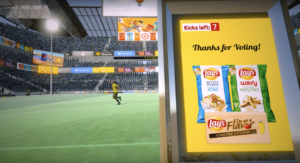Virtual Louis Vitton? Free Pizza for Advancing Levels? I’m Game!
The Current State of Personalization
I don’t know about you, but I love getting customized recommendations on Spotify. Sometimes I feel like they know me better than I know myself! And that’s the point exactly.
In recent years, the personalization phenomenon has transformed consumer experiences. From algorithms that predict shows you are likely to watch and enjoy on Netflix, to custom product recommendations on Amazon (yes, that’s how I found that new book on my nightstand!), the era of personalization is alive and kicking.
Today’s young audiences of digital natives have come to expect personalized experiences in all aspects of their lives, including in the ads they see. In a survey of over 8000 consumers across countries, Accenture found that 91% of customers are more likely to choose brands that recognize, remember, and provide relevant offers and recommendations. Marketers have taken note.
The technology is becoming more sophisticated to match this move. Advertisers can now hone in on demographics beyond simply age and gender, delivering consumers the right message at the right time via the right channel. And when it comes to channels, advertisers are beginning to take note of the colossal, connected audiences inside video games, a platform ripe for advertising personalization. With 2.6 billion gamers worldwide, it’s about time!
Read more: In-Game Advertising 101
Video Games? Really? Yes!
Gaming is not just teenage boys in their basements anymore. Across genders, income levels, and continents, more diverse people are gaming than ever before. In fact, the gaming industry is now bigger than Hollywood. And the news just keeps getting better: despite the medium’s wide reach, the majority of today’s gamers fall into the 18-34-year-old age bracket, a demographic that holds massive purchasing potential.
All this is to say that in-game advertising presents an unprecedented opportunity for advertisers. And with advancements in technology that allow for completely immersive in-game ad placements, more and more brands are going in-game. So it’s becoming clear- personalization is one next big thing (or current thing!) in advertising, and in-game is another next big thing in advertising. Let’s see how these two can work together.
Why Advertising Personalization in Games (Hint: It’s Good for Everyone)
 Anzu in-game ads | Image Credit: Anzu.io
Anzu in-game ads | Image Credit: Anzu.io
We are already witnessing a high-level of data-driven personalization, in general, taking place in video games. Gamers can choose how their in-game persona looks by selecting features as specific as hairstyle, gender, clothing, skin color, eye color, and more. Or they can choose to play as their famous athlete or celebrity (Rocky Balboa..or Muhammed Ali?..hmm). When one thinks of personalization in-game, the conversation is often restricted to these types of gamer-driven experiences.
In-game advertising personalization is a different level of “custom,” one that can connect gamers with non-disruptive, ultra-relevant ads that match their demographics, interests, and even location (so if you’re a few blocks away from Pizza Hut, you can win an in-game coupon for a free pie, for example).
The icing on the cake: the ultra-immersive nature of games. By default, players are completely absorbed in the gaming experience, which results in especially high viewability for naturally-placed ads. A recent report by Ad Viewability Measurement Solution Cheq and Anzu.io showed that in-game ads have 23% higher viewability than out-of-game ads. Another added benefit is that when ads appeal naturally within the gaming environment, users feel less resistance towards them, and may even begin to associate those brands with the positive gaming experiences they love so much.
But How Does It Work?
Using a combination of new tech, intelligent data, and cross-channel integration, in-game advertising can be personalized to dynamically serve the right ads at the relevant moments. By offering users truly relevant advertising, brands can use in-game as another touchpoint that unites their online and offline campaigns (think back to the Pizza Hut example from earlier). With new advertising technologies, these kinds of campaigns can now be delivered in-game at scale.
 Anzu in-game ads | Image Credit: Anzu.io
Anzu in-game ads | Image Credit: Anzu.io
One of the ways brands can experiment with personalized in-game advertising is through advergames. Advergames have been around for a while, but personalized advergames represent a new level in interactivity. For instance, if a gamer has successfully completed a level or achieved a certain milestone, positive messaging can boost gamer confidence. This is a great time to expose that gamer to a relevant ad such as a slot machine that lets them “win” a relevant prize. Or, if a gamer is struggling to move through a level, they can be targeted with branded bonuses that help them advance.
The Personalization and Privacy Paradox
New privacy laws present somewhat of a conundrum for personalized advertising. On the one hand, consumers prefer tailor-made ad messaging that is highly relevant to them. On the other hand, new privacy and data regulations such as GDPR make it more difficult for advertisers to access the first-party data needed for digital ad personalization.
But there are solutions on the horizon. Advertisers can still personalize messaging and share relevant ads via applied Machine Learning algorithms that utilize AI. Ads served this way are likely to have better response rates as they are highly tailored to the individual’s playing patterns. These algorithms can also be used to predict the next user action and to weed out ads that don’t work well.
Another solution is offering players the opportunity to opt into personalized advertising. When they understand that allowing in-game personalization will only serve to improve their gaming experience, they may be more likely to share their data willingly.
Smart, Personal, Efficient, and In-Game
We’ve now learned how and why personalized in-game advertising can be an effective way to boost brand recall and affinity, and how new privacy and data laws are not necessarily an impediment to that effectiveness. eCommerce, for example, has already shown us how sophisticated algorithms and machine-learning can create highly-personalized experiences that improve user conversion (I actually just found my new favorite band via Spotify recommendations. Thank you, personalization!).
 Louis Vitton & League of Legends Collaboration | Image Credit: Riot Games
Louis Vitton & League of Legends Collaboration | Image Credit: Riot Games
What will be next? Branded in-game items? That’s already here. Luxury fashion house Louis Vuitton designed the trophy case for the 2019 League of Legends World Championship. How about AR gaming, but with brands? Think Pokemon Go where players embark on scavenger hunts and engage with real-world brands along the way.
It’s clear that the possibilities for personalized in-game advertising are unlimited and the potential is huge. The question that remains for brands is: are you game?
Read more: The Seven Deadly Sins of Ad Tech











